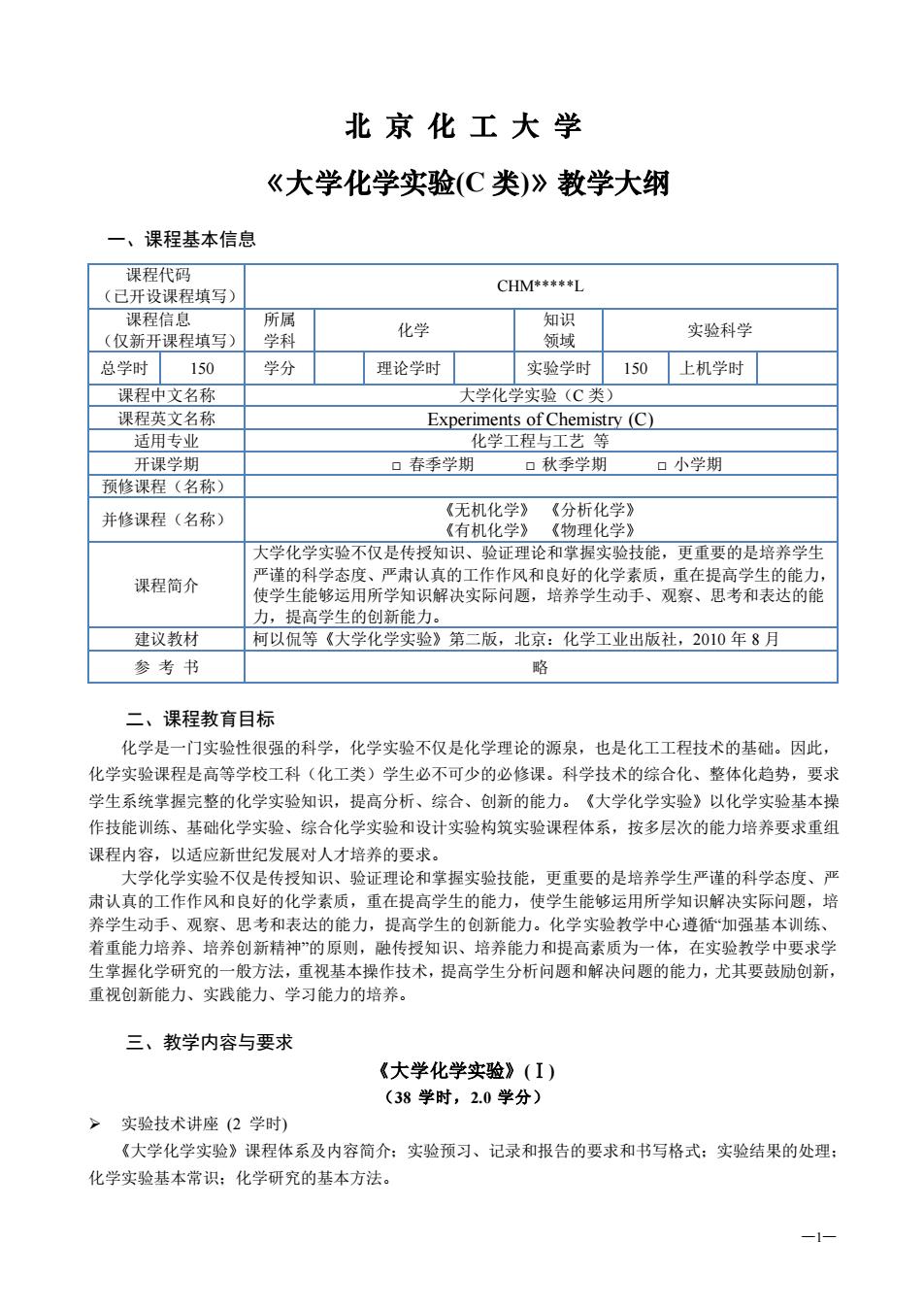
北京化工大学 《大学化学实验(C类)》教学大纲 一、课程基本信息 程信 (仅新开课程填写) 化学 实验科学 总学时150 学分 理论学时 实验学时 150上机学时 课程中文名称 大学化学实验(C类 裸程英文名称 Experiments of Chemistry (C) 道用专到 化学工程与工艺 开字地 。春季学期 口秋季学期 口小学期 预修课程(名称) 并修课程(名称) 《无机化学》《分析化学》 《有机 物理化 大学化学实验不仅是传授知识、验证理论和掌握 验技能,更重要的是培养学生 课程简介 递的料 和良好的化学素质 提和表达的能 建议教材 柯以侃等《大学化学实验》第二版,北京:化学工业出版社,2010年8月 参考书 略 二、课程教育目标 化学是一门实哈性很强的科学,化学实验不仅是化学理论的源泉,也是化工工程技术的基兜。因此 化学实验课程是高等学校工科(化工类)学生必不可少的必修课。科学技术的综合化、整体化趋势,要求 学生系统掌握完整的化学实验知识,提高分析、综合、创新的能力。《大学化学实验》以化学实验基本操 作技能训练、基础化学实验、综合化学实验和设计实验构筑实验课程体系,按多层次的能力培养要求重组 课程内容,以适应新世纪发展对人才培养的要求。 大学化学实验不仅是传授知识、验证理论和掌握实验技能,更重要的是培养学生严谨的科学态度、严 肃认真的工作作风和良好的化学素质,重在提高学生的能力,使学生能够运用所学知识解决实际问题,培 养学生动手、观察、思考和表达的能力,提高学生的创新能力。化学实验教学中心遵循加强基本训练、 着重能力培养、培养创新精神的原则,融传授知识、培养能力和提高素质为一体,在实验教学中要求学 生堂化学研究的 去,重视基本操作技术,提高学生分析问题和解决问题的能力,尤其要鼓励创新 重视创新能力、实践能力、学习能力的培养 三、教学内容与要求 《大学化学实验》(I) (38学时,2.0学分) >实验技术讲座(2学时) 《大学化学实验》课程体系及内容简介:实验预习、记录和报告的要求和书写格式:实验结果的处理: 化学实验基本常识:化学研究的基本方法。 -1
—1— 北 京 化 工 大 学 《大学化学实验(C 类)》教学大纲 一、课程基本信息 课程代码 (已开设课程填写) CHM*****L 课程信息 (仅新开课程填写) 所属 学科 化学 知识 领域 实验科学 总学时 150 学分 理论学时 实验学时 150 上机学时 课程中文名称 大学化学实验(C 类) 课程英文名称 Experiments of Chemistry (C) 适用专业 化学工程与工艺 等 开课学期 □ 春季学期 □ 秋季学期 □ 小学期 预修课程(名称) 并修课程(名称) 《无机化学》 《分析化学》 《有机化学》 《物理化学》 课程简介 大学化学实验不仅是传授知识、验证理论和掌握实验技能,更重要的是培养学生 严谨的科学态度、严肃认真的工作作风和良好的化学素质,重在提高学生的能力, 使学生能够运用所学知识解决实际问题,培养学生动手、观察、思考和表达的能 力,提高学生的创新能力。 建议教材 柯以侃等《大学化学实验》第二版,北京:化学工业出版社,2010 年 8 月 参 考 书 略 二、课程教育目标 化学是一门实验性很强的科学,化学实验不仅是化学理论的源泉,也是化工工程技术的基础。因此, 化学实验课程是高等学校工科(化工类)学生必不可少的必修课。科学技术的综合化、整体化趋势,要求 学生系统掌握完整的化学实验知识,提高分析、综合、创新的能力。《大学化学实验》以化学实验基本操 作技能训练、基础化学实验、综合化学实验和设计实验构筑实验课程体系,按多层次的能力培养要求重组 课程内容,以适应新世纪发展对人才培养的要求。 大学化学实验不仅是传授知识、验证理论和掌握实验技能,更重要的是培养学生严谨的科学态度、严 肃认真的工作作风和良好的化学素质,重在提高学生的能力,使学生能够运用所学知识解决实际问题,培 养学生动手、观察、思考和表达的能力,提高学生的创新能力。化学实验教学中心遵循“加强基本训练、 着重能力培养、培养创新精神”的原则,融传授知识、培养能力和提高素质为一体,在实验教学中要求学 生掌握化学研究的一般方法,重视基本操作技术,提高学生分析问题和解决问题的能力,尤其要鼓励创新, 重视创新能力、实践能力、学习能力的培养。 三、教学内容与要求 《大学化学实验》(Ⅰ) (38 学时,2.0 学分) ➢ 实验技术讲座 (2 学时) 《大学化学实验》课程体系及内容简介;实验预习、记录和报告的要求和书写格式;实验结果的处理; 化学实验基本常识;化学研究的基本方法
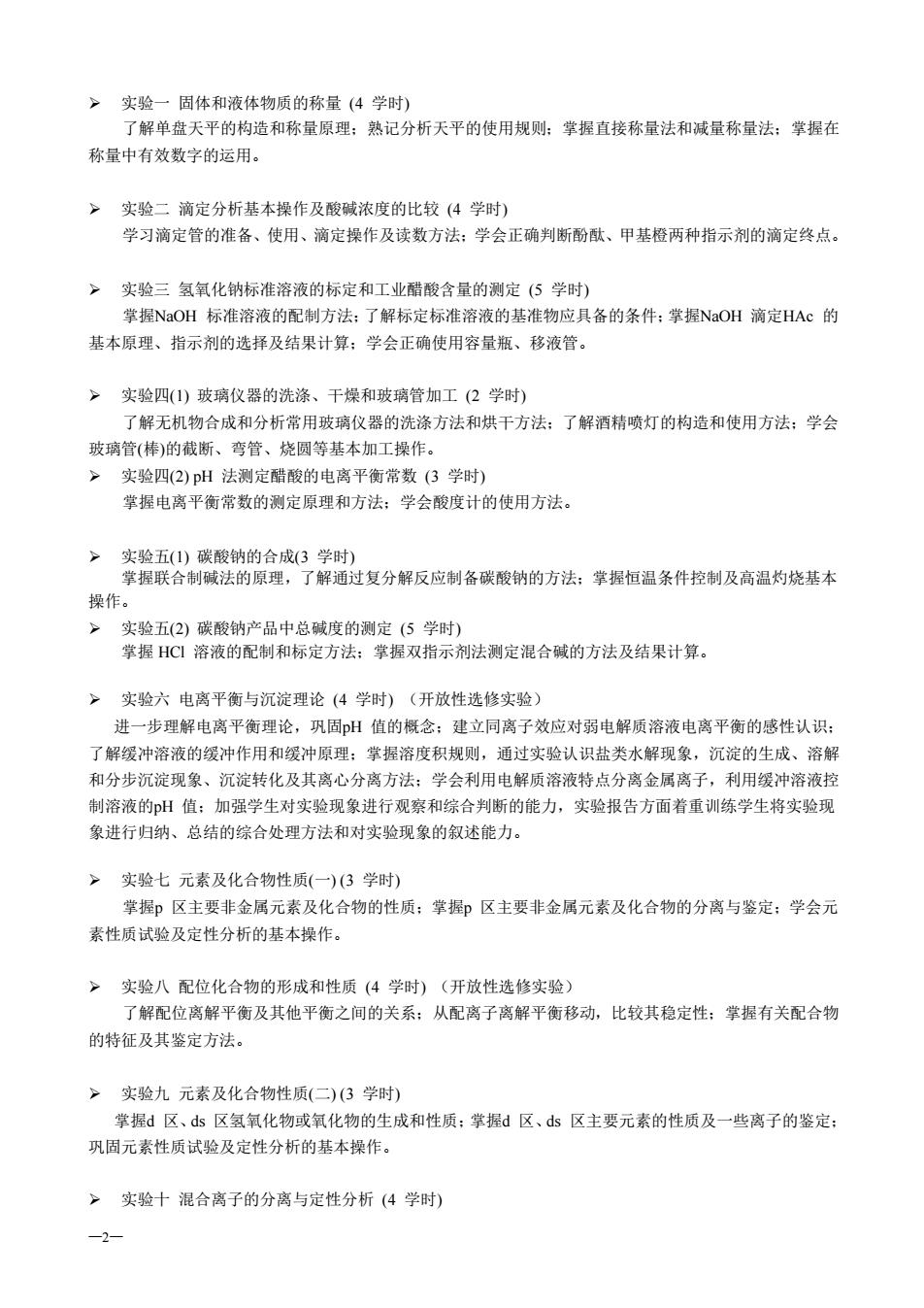
实验一固体和液体物质的称量(4学时) 了解单盘天平的构造和称量原理:熟记分析天平的使用规则:掌握直接称量法和减量称量法:掌握在 称量中有效数字的运用。 >实验二滴定分析基本操作及酸碱浓度的比较(4学时) 学习滴定管的准备、使用、滴定操作及读数方法:学会正确判断酚酞、甲基橙两种指示剂的滴定终点。 >实验三氢氧化钠标准溶液的标定和工业醋酸含量的测定(⑤学时) 掌握NaOH标准溶液的配制方法:了解标定标准溶液的基准物应具备的条件;掌握NaOH滴定HAc的 基本原理、指示剂的选择及结果计算:学会正确使用容量瓶、移液管。 实验四(1)玻璃仪器的洗涤、干燥和玻璃管加工(2学时) 了解无机物合成和分析常用玻璃仪器的洗涤方法和烘干方法:了解酒精喷灯的构造和使用方法:学会 玻璃管(棒)的截断、弯管、烧圆等基本加工操作。 >实验四(2)pH法测定醋酸的电离平衡常数(3学时) 掌握电离平衡常数的测定原理和方法:学会酸度计的使用方法。 实验五(1)碳酸钠的合成(3学时) 掌握联合制碱法的原理,了解通过复分解反应制备碳酸钠的方法:掌握恒温条件控制及高温灼烧基本 操作。 实验五(2)碳酸钠产品中总碱度的测定(5学时) 掌握HC!溶液的配制和标定方法:掌握双指示剂法测定混合碱的方法及结果计算。 >实验六电离平衡与沉淀理论(4学时)(开放性选修实验) 进一步理解电离平衡理论,巩固H值的概念:建立同离子效应对弱电解质溶液电离平衡的感性认识 了解缓冲溶液的缓冲作用和缓冲原理:掌握溶度积规则,通过实验认识盐类水解现象,沉淀的生成、溶解 和分步沉淀现象、沉淀转化及其离心分离方法:学会利用电解质溶液特点分离金属离子,利用缓冲溶液控 制溶液的H值:加强学生对实验现象进行观察和综合判断的能力,实验报告方面着重训练学生将实验现 象进行归纳、总结的综合处理方法和对实验现象的叙述能力。 实验七元素及化合物性质(一)3学时 掌握印区主要非金属元素及化合物的性质:掌握即区主要非金属元素及化合物的分离与鉴定:学会元 素性质试验及定性分析的基本操作。 实验八配位化合物的形成和性质(4学时)(开放性选修实险) 了解配位离解平衡及其他平衡之间的关系:从配离子离解平衡移动,比较其稳定性:掌握有关配合物 的特征及其鉴定方法。 实验九元素及化合物性质(二)(3学时) 掌握d区、ds区氢氧化物或氧化物的生成和性质:掌握d区、ds区主要元素的性质及一些离子的鉴定: 巩固元素性质试验及定性分析的基本操作。 >实验十混合离子的分离与定性分析(4学时) -2
—2— ➢ 实验一 固体和液体物质的称量 (4 学时) 了解单盘天平的构造和称量原理;熟记分析天平的使用规则;掌握直接称量法和减量称量法;掌握在 称量中有效数字的运用。 ➢ 实验二 滴定分析基本操作及酸碱浓度的比较 (4 学时) 学习滴定管的准备、使用、滴定操作及读数方法;学会正确判断酚酞、甲基橙两种指示剂的滴定终点。 ➢ 实验三 氢氧化钠标准溶液的标定和工业醋酸含量的测定 (5 学时) 掌握NaOH 标准溶液的配制方法;了解标定标准溶液的基准物应具备的条件;掌握NaOH 滴定HAc 的 基本原理、指示剂的选择及结果计算;学会正确使用容量瓶、移液管。 ➢ 实验四(1) 玻璃仪器的洗涤、干燥和玻璃管加工 (2 学时) 了解无机物合成和分析常用玻璃仪器的洗涤方法和烘干方法;了解酒精喷灯的构造和使用方法;学会 玻璃管(棒)的截断、弯管、烧圆等基本加工操作。 ➢ 实验四(2) pH 法测定醋酸的电离平衡常数 (3 学时) 掌握电离平衡常数的测定原理和方法;学会酸度计的使用方法。 ➢ 实验五(1) 碳酸钠的合成(3 学时) 掌握联合制碱法的原理,了解通过复分解反应制备碳酸钠的方法;掌握恒温条件控制及高温灼烧基本 操作。 ➢ 实验五(2) 碳酸钠产品中总碱度的测定 (5 学时) 掌握 HCl 溶液的配制和标定方法;掌握双指示剂法测定混合碱的方法及结果计算。 ➢ 实验六 电离平衡与沉淀理论 (4 学时) (开放性选修实验) 进一步理解电离平衡理论,巩固pH 值的概念;建立同离子效应对弱电解质溶液电离平衡的感性认识; 了解缓冲溶液的缓冲作用和缓冲原理;掌握溶度积规则,通过实验认识盐类水解现象,沉淀的生成、溶解 和分步沉淀现象、沉淀转化及其离心分离方法;学会利用电解质溶液特点分离金属离子,利用缓冲溶液控 制溶液的pH 值;加强学生对实验现象进行观察和综合判断的能力,实验报告方面着重训练学生将实验现 象进行归纳、总结的综合处理方法和对实验现象的叙述能力。 ➢ 实验七 元素及化合物性质(一) (3 学时) 掌握p 区主要非金属元素及化合物的性质;掌握p 区主要非金属元素及化合物的分离与鉴定;学会元 素性质试验及定性分析的基本操作。 ➢ 实验八 配位化合物的形成和性质 (4 学时) (开放性选修实验) 了解配位离解平衡及其他平衡之间的关系;从配离子离解平衡移动,比较其稳定性;掌握有关配合物 的特征及其鉴定方法。 ➢ 实验九 元素及化合物性质(二) (3 学时) 掌握d 区、ds 区氢氧化物或氧化物的生成和性质;掌握d 区、ds 区主要元素的性质及一些离子的鉴定; 巩固元素性质试验及定性分析的基本操作。 ➢ 实验十 混合离子的分离与定性分析 (4 学时)
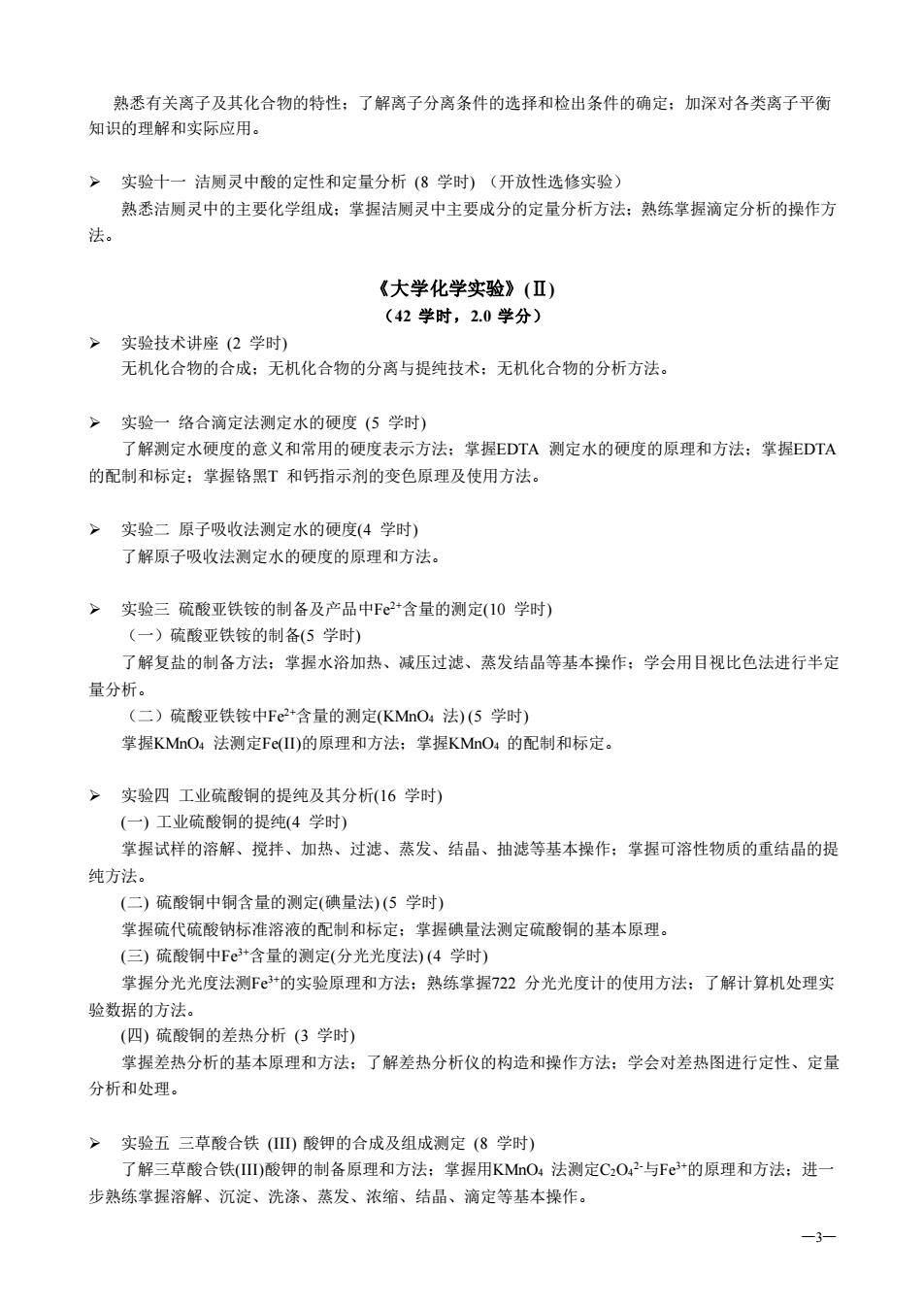
熟悉有关离子及其化合物的特性:了解离子分离条件的选择和检出条件的确定:加深对各类离子平衡 知识的理解和实际应用。 一实验十一洁啊灵中酸的定性和定量分折(8学时)(开放性洗修实验) 熟悉洁厕灵中的主要化学组成:掌握洁厕灵中主要成分的定量分析方法:熟练掌握滴定分析的操作方 法。 《大学化学实验》(Ⅱ) (42学时,2.0学分) >实验技术讲座(2学时) 无机化合物的合成:无机化合物的分离与提纯技术:无机化合物的分析方法。 >实验一络合滴定法测定水的硬度(5学时) 了解测定水硬度的意义和常用的硬度表示方法:掌握EDTA测定水的硬度的原理和方法:掌握EDTA 的配制和标定:掌握铬黑T和钙指示剂的变色原理及使用方法。 实验二原子吸收法测定水的硬度(4学时) 了解原子吸收法测定水的硬度的原理和方法。 >实验三硫酸亚铁铵的制备及产品中F2+含量的测定(10学时) (一)硫酸亚铁铵的制备(5学时) 了解复盐的制备方法:掌握水浴加热、减压过滤、蒸发结品等基本操作:学会用目视比色法进行半定 量分析。 (二)硫酸亚铁铵中Fe2*含量的测定(KMnO,法)(5学时) 掌握KMO4法测定Fc()的原理和方法:掌握KMnO:的配制和标定。 实验四工业硫酸铜的提纯及其分析(16学时) (一)工业硫酸铜的提纯(4学时) 掌握试样的溶解、搅拌、加热、过滤、蒸发、结晶、抽滤等基本操作:掌握可溶性物质的重结晶的提 纯方法。 二)硫酸铜中铜含量的测定(碘量法)(5学时) 掌握硫代硫酸钠标准溶液的配制和标定:掌握碘量法测定硫酸铜的基本原理。 (三)硫酸制中F+含量的测定(分光光度法)(4学时) 掌握分光光度法测F+的实验原理和方法:熟练掌握722分光光度计的使用方法:了解计算机处理实 验数据的方法。 (四)硫酸铜的差热分析(3学时) 掌握差热分析的基本原理和方法:了解差热分析仪的构造和操作方法:学会对差热图进行定性、定量 分析和处理。 实验五三草酸合铁)酸钾的合成及组成测定(8学时) 了解三草酸合铁)酸钾的制各原理和方法:掌握用KMO4法测定CO42与F的原理和方法:进 步熟练掌握溶解、沉淀、洗涤、蒸发、浓缩、结品、滴定等基本操作。 -3
—3— 熟悉有关离子及其化合物的特性;了解离子分离条件的选择和检出条件的确定;加深对各类离子平衡 知识的理解和实际应用。 ➢ 实验十一 洁厕灵中酸的定性和定量分析 (8 学时) (开放性选修实验) 熟悉洁厕灵中的主要化学组成;掌握洁厕灵中主要成分的定量分析方法;熟练掌握滴定分析的操作方 法。 《大学化学实验》(Ⅱ) (42 学时,2.0 学分) ➢ 实验技术讲座 (2 学时) 无机化合物的合成;无机化合物的分离与提纯技术;无机化合物的分析方法。 ➢ 实验一 络合滴定法测定水的硬度 (5 学时) 了解测定水硬度的意义和常用的硬度表示方法;掌握EDTA 测定水的硬度的原理和方法;掌握EDTA 的配制和标定;掌握铬黑T 和钙指示剂的变色原理及使用方法。 ➢ 实验二 原子吸收法测定水的硬度(4 学时) 了解原子吸收法测定水的硬度的原理和方法。 ➢ 实验三 硫酸亚铁铵的制备及产品中Fe2+含量的测定(10 学时) (一)硫酸亚铁铵的制备(5 学时) 了解复盐的制备方法;掌握水浴加热、减压过滤、蒸发结晶等基本操作;学会用目视比色法进行半定 量分析。 (二)硫酸亚铁铵中Fe2+含量的测定(KMnO4 法) (5 学时) 掌握KMnO4 法测定Fe(II)的原理和方法;掌握KMnO4 的配制和标定。 ➢ 实验四 工业硫酸铜的提纯及其分析(16 学时) (一) 工业硫酸铜的提纯(4 学时) 掌握试样的溶解、搅拌、加热、过滤、蒸发、结晶、抽滤等基本操作;掌握可溶性物质的重结晶的提 纯方法。 (二) 硫酸铜中铜含量的测定(碘量法) (5 学时) 掌握硫代硫酸钠标准溶液的配制和标定;掌握碘量法测定硫酸铜的基本原理。 (三) 硫酸铜中Fe3+含量的测定(分光光度法) (4 学时) 掌握分光光度法测Fe3+的实验原理和方法;熟练掌握722 分光光度计的使用方法;了解计算机处理实 验数据的方法。 (四) 硫酸铜的差热分析 (3 学时) 掌握差热分析的基本原理和方法;了解差热分析仪的构造和操作方法;学会对差热图进行定性、定量 分析和处理。 ➢ 实验五 三草酸合铁 (III) 酸钾的合成及组成测定 (8 学时) 了解三草酸合铁(III)酸钾的制备原理和方法;掌握用KMnO4 法测定C2O4 2-与Fe3+的原理和方法;进一 步熟练掌握溶解、沉淀、洗涤、蒸发、浓缩、结晶、滴定等基本操作
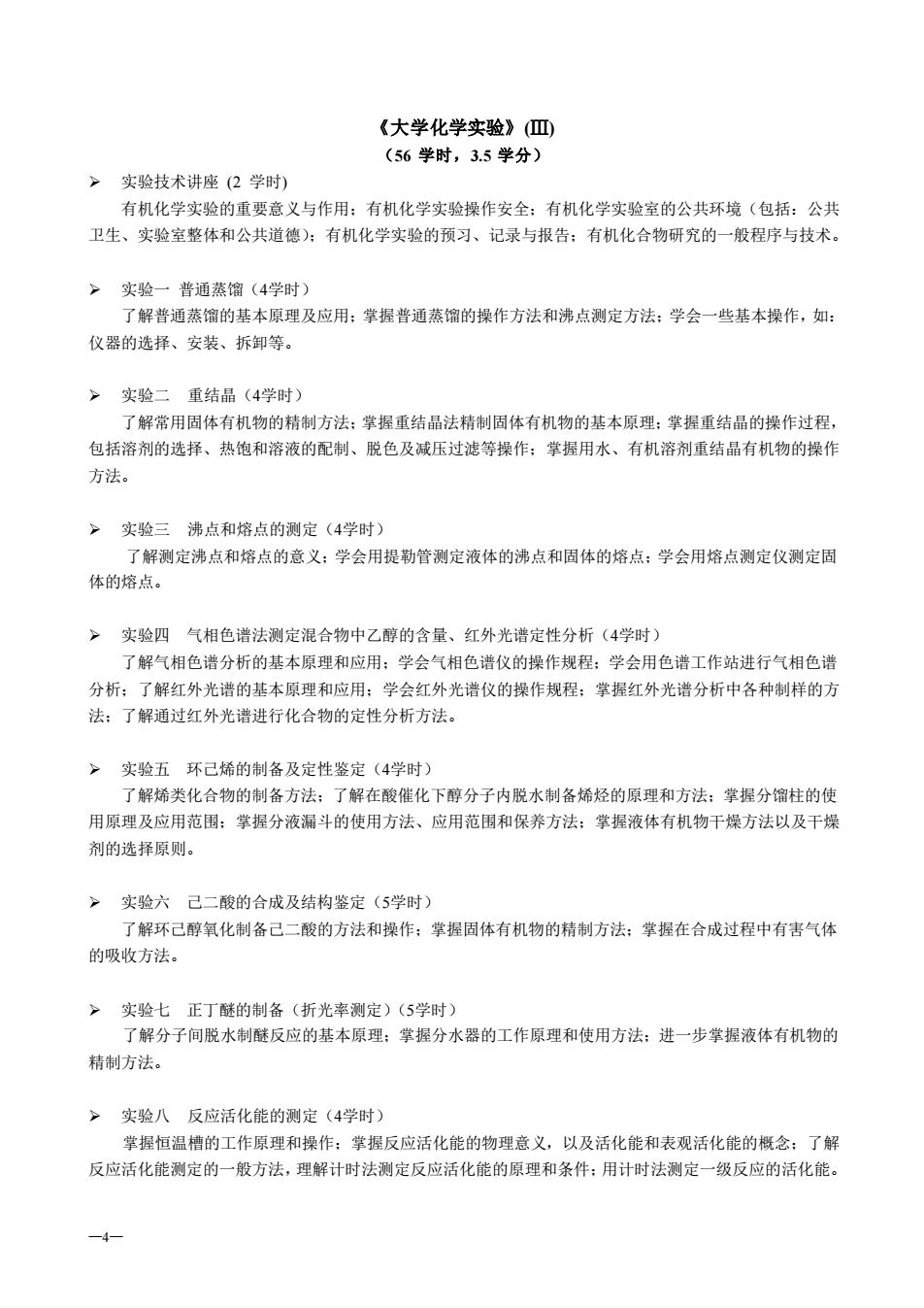
《大学化学实验》皿 (56学时,3.5学分) >实验技术讲座(2学时) 有机化学实验的重要意义与作用:有机化学实验操作安全:有机化学实验室的公共环境(包括:公共 卫生、实验室整体和公共道德):有机化学实验的预习、记录与报告:有机化合物研究的一般程序与技术。 >实验一普通蒸馏(4学时) 了解普通蒸馏的基本原理及应用:掌握普通蒸馏的操作方法和沸点测定方法学会一些基本操作,如: 仪器的选择、安装、拆卸等。 >实验二重结晶(4学时) 了解常用固体有机物的精制方法:掌握重结晶法精制周体有机物的基本原理:掌握重结晶的操作过程, 包括溶剂的选择、热饱和溶液的配制、脱色及减压过滤等操作:掌握用水、有机溶剂重结晶有机物的操作 方法。 >实验三沸点和熔点的测定(4学时) 了解测定沸点和熔点的意义:学会用提勒管测定液体的沸点和固体的熔点:学会用熔点测定仪测定固 体的熔点。 >实验四气相色谱法测定混合物中乙醇的含量、红外光谱定性分析(4学时) 了解气相色谱分析的基本原理和应用:学会气相色谱仪的操作规程:学会用色谱工作站进行气相色谱 分析:了解红外光谱的基本原理和应用:学会红外光谱仪的操作规程:掌握红外光谱分析中各种制样的方 法:了解通过红外光谱进行化合物的定性分析方法。 >实验五环己烯的制备及定性鉴定(4学时) 了解烯类化合物的制备方法:了解在酸催化下醇分子内脱水制备烯烃的原理和方法:掌握分馏柱的使 用原理及应用范围:掌握分液漏斗的使用方法、应用范围和保养方法:掌握液体有机物干燥方法以及干燥 剂的选择原则。 >实验六己二酸的合成及结构鉴定(5学时) 了解环己醇氧化制备己二酸的方法和操作:掌握固体有机物的精制方法:掌握在合成过程中有害气体 的吸收方法。 >实验七正丁醚的制备(折光率测定)(5学时) 了解分子间脱水制隧反应的基本原理:掌握分水器的工作原理和使用方法:进一步掌握液体有机物的 精制方法。 >实验八反应活化能的测定(4学时) 掌握恒温槽的工作原理和操作:掌握反应活化能的物理意义,以及活化能和表观活化能的概念:了解 反应活化能测定的一般方法,理解计时法测定反应活化能的原理和条件:用计时法测定一级反应的活化能。 -4
—4— 《大学化学实验》(Ⅲ) (56 学时,3.5 学分) ➢ 实验技术讲座 (2 学时) 有机化学实验的重要意义与作用;有机化学实验操作安全;有机化学实验室的公共环境(包括:公共 卫生、实验室整体和公共道德);有机化学实验的预习、记录与报告;有机化合物研究的一般程序与技术。 ➢ 实验一 普通蒸馏(4学时) 了解普通蒸馏的基本原理及应用;掌握普通蒸馏的操作方法和沸点测定方法;学会一些基本操作,如: 仪器的选择、安装、拆卸等。 ➢ 实验二 重结晶(4学时) 了解常用固体有机物的精制方法;掌握重结晶法精制固体有机物的基本原理;掌握重结晶的操作过程, 包括溶剂的选择、热饱和溶液的配制、脱色及减压过滤等操作;掌握用水、有机溶剂重结晶有机物的操作 方法。 ➢ 实验三 沸点和熔点的测定(4学时) 了解测定沸点和熔点的意义;学会用提勒管测定液体的沸点和固体的熔点;学会用熔点测定仪测定固 体的熔点。 ➢ 实验四 气相色谱法测定混合物中乙醇的含量、红外光谱定性分析(4学时) 了解气相色谱分析的基本原理和应用;学会气相色谱仪的操作规程;学会用色谱工作站进行气相色谱 分析;了解红外光谱的基本原理和应用;学会红外光谱仪的操作规程;掌握红外光谱分析中各种制样的方 法;了解通过红外光谱进行化合物的定性分析方法。 ➢ 实验五 环己烯的制备及定性鉴定(4学时) 了解烯类化合物的制备方法;了解在酸催化下醇分子内脱水制备烯烃的原理和方法;掌握分馏柱的使 用原理及应用范围;掌握分液漏斗的使用方法、应用范围和保养方法;掌握液体有机物干燥方法以及干燥 剂的选择原则。 ➢ 实验六 己二酸的合成及结构鉴定(5学时) 了解环己醇氧化制备己二酸的方法和操作;掌握固体有机物的精制方法;掌握在合成过程中有害气体 的吸收方法。 ➢ 实验七 正丁醚的制备(折光率测定)(5学时) 了解分子间脱水制醚反应的基本原理;掌握分水器的工作原理和使用方法;进一步掌握液体有机物的 精制方法。 ➢ 实验八 反应活化能的测定(4学时) 掌握恒温槽的工作原理和操作;掌握反应活化能的物理意义,以及活化能和表观活化能的概念;了解 反应活化能测定的一般方法,理解计时法测定反应活化能的原理和条件;用计时法测定一级反应的活化能
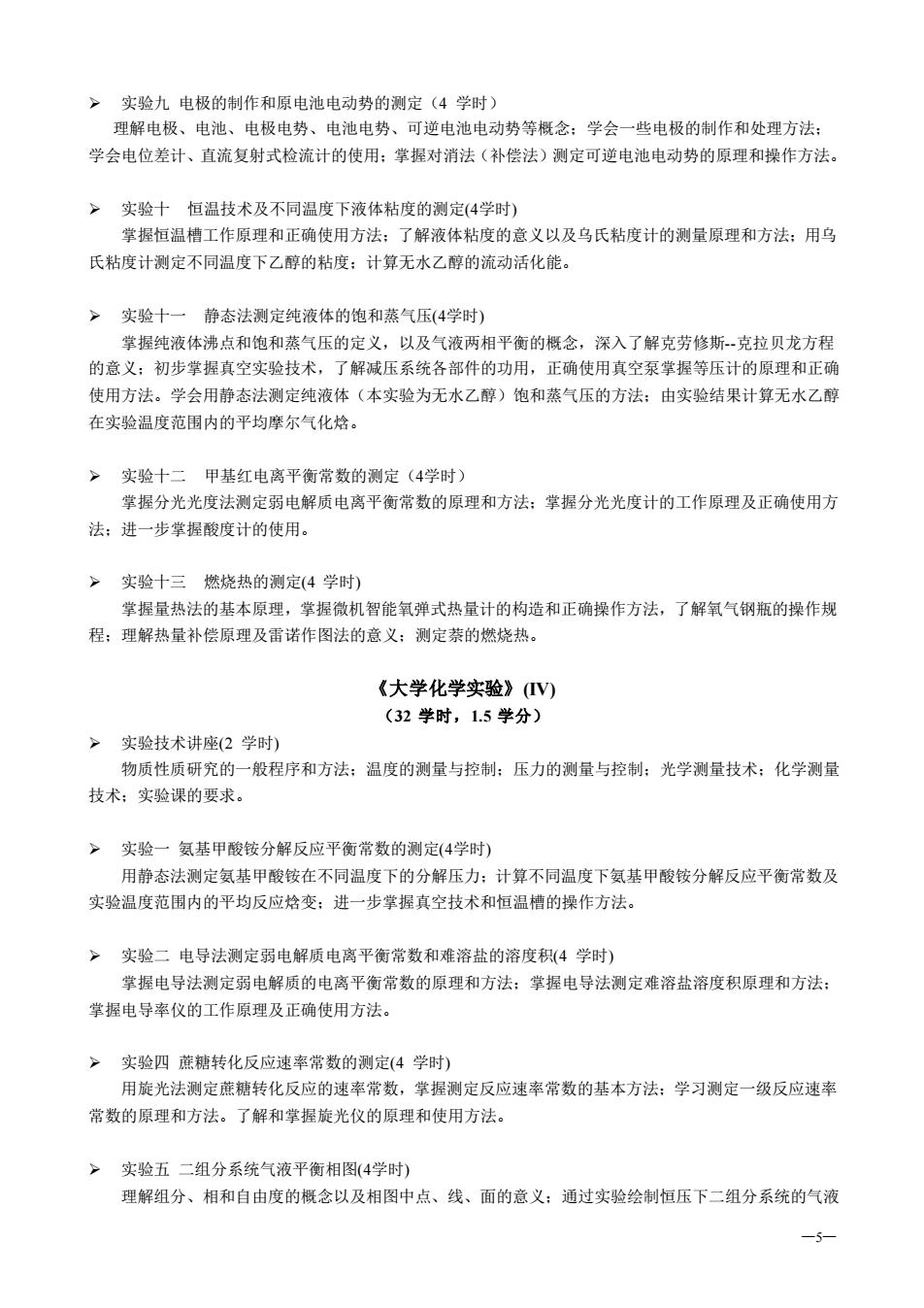
一实验九电极的制作和原电池电动势的测定(4学时) 理解电极、电池、电极电势、电池电势、可逆电池电动势等概念:学会一些电极的制作和处理方法 学会电位差计、直流复射式检流计的使用:掌握对消法(补偿法)测定可逆电池电动势的原理和操作方法。 >实验十恒温技术及不同温度下液体粘度的测定(4学时) 掌握恒温槽工作原理和正确使用方法:了解液体粘度的意义以及乌氏粘度计的测量原理和方法:用乌 氏粘度计测定不同温度下乙醇的粘度:计算无水乙醇的流动活化能。 实验十一静态法测定纯液体的饱和蒸气压(4学时) 掌握纯液体沸点和饱和蒸气压的定义,以及气液两相平衡的概念,深入了解克劳修斯-克拉贝龙方程 的意义:初步掌握真空实验技术,了解减压系统各部件的功用,正确使用真空泵掌握等压计的原理和正确 使用方法。学会用静态法测定纯液体(本实验为无水乙醇)饱和蒸气压的方法:由实验结果计算无水乙醇 在实验温度范围内的平均摩尔气化格。 >实验十二甲基红电离平衡常数的测定(4学时) 掌握分光光度法测定弱电解质电离平衡常数的原理和方法:掌握分光光度计的工作原理及正确使用方 法:进一步掌握酸度计的使用 >实验十三燃烧热的测定(4学时) 掌握量热法的基本原理,掌捉微机智能氧弹式热量计的构造和正确操作方法,了解氧气钢瓶的操作规 程:理解热量补偿原理及雷诺作图法的意义:测定萘的燃烧热。 《大学化学实验》V) (32学时,1.5学分) 实验技术讲座(2学时) 物质性质研究的一般程序和方法:温度的测量与控制:压力的测量与控制:光学测量技术:化学测量 技术:实验课的要求 实验一氨基甲酸铵分解反应平衡常数的测定(4学时) 用静态法测定氨基甲酸铵在不同温度下的分解压力:计算不同温度下氨基甲酸铵分解反应平衡常数及 实验温度范围内的平均反应焓变:进一步掌握真空技术和恒温槽的操作方法。 >实验二电导法测定弱电解质电离平衡常数和难溶盐的溶度积(4学时) 掌握电导法测定弱电解质的电离平衡常数的原理和方法:掌握电导法测定难溶盐溶度积原理和方法 掌握电导率仪的工作原理及正确使用方法。 >实验四蔗糖转化反应速率常数的测定(4学时) 用旋光法测定蔗糖转化反应的速率常数,掌握测定反应速率常数的基本方法:学习测定一级反应速率 常数的原理和方法。了解和掌握旋光仪的原理和使用方法。 实验五二组分系统气液平衡相图(4学时) 理解组分、相和自由度的概念以及相图中点、线、面的意义:通过实验绘制恒压下二组分系统的气液 -5
—5— ➢ 实验九 电极的制作和原电池电动势的测定(4 学时) 理解电极、电池、电极电势、电池电势、可逆电池电动势等概念;学会一些电极的制作和处理方法; 学会电位差计、直流复射式检流计的使用;掌握对消法(补偿法)测定可逆电池电动势的原理和操作方法。 ➢ 实验十 恒温技术及不同温度下液体粘度的测定(4学时) 掌握恒温槽工作原理和正确使用方法;了解液体粘度的意义以及乌氏粘度计的测量原理和方法;用乌 氏粘度计测定不同温度下乙醇的粘度;计算无水乙醇的流动活化能。 ➢ 实验十一 静态法测定纯液体的饱和蒸气压(4学时) 掌握纯液体沸点和饱和蒸气压的定义,以及气液两相平衡的概念,深入了解克劳修斯--克拉贝龙方程 的意义;初步掌握真空实验技术,了解减压系统各部件的功用,正确使用真空泵掌握等压计的原理和正确 使用方法。学会用静态法测定纯液体(本实验为无水乙醇)饱和蒸气压的方法;由实验结果计算无水乙醇 在实验温度范围内的平均摩尔气化焓。 ➢ 实验十二 甲基红电离平衡常数的测定(4学时) 掌握分光光度法测定弱电解质电离平衡常数的原理和方法;掌握分光光度计的工作原理及正确使用方 法;进一步掌握酸度计的使用。 ➢ 实验十三 燃烧热的测定(4 学时) 掌握量热法的基本原理,掌握微机智能氧弹式热量计的构造和正确操作方法,了解氧气钢瓶的操作规 程;理解热量补偿原理及雷诺作图法的意义;测定萘的燃烧热。 《大学化学实验》(IV) (32 学时,1.5 学分) ➢ 实验技术讲座(2 学时) 物质性质研究的一般程序和方法;温度的测量与控制;压力的测量与控制;光学测量技术;化学测量 技术;实验课的要求。 ➢ 实验一 氨基甲酸铵分解反应平衡常数的测定(4学时) 用静态法测定氨基甲酸铵在不同温度下的分解压力;计算不同温度下氨基甲酸铵分解反应平衡常数及 实验温度范围内的平均反应焓变;进一步掌握真空技术和恒温槽的操作方法。 ➢ 实验二 电导法测定弱电解质电离平衡常数和难溶盐的溶度积(4 学时) 掌握电导法测定弱电解质的电离平衡常数的原理和方法;掌握电导法测定难溶盐溶度积原理和方法; 掌握电导率仪的工作原理及正确使用方法。 ➢ 实验四 蔗糖转化反应速率常数的测定(4 学时) 用旋光法测定蔗糖转化反应的速率常数,掌握测定反应速率常数的基本方法;学习测定一级反应速率 常数的原理和方法。了解和掌握旋光仪的原理和使用方法。 ➢ 实验五 二组分系统气液平衡相图(4学时) 理解组分、相和自由度的概念以及相图中点、线、面的意义;通过实验绘制恒压下二组分系统的气液

平衡相图:了解阿贝折射仪的结构和原理,掌握阿贝折射仪的使用方法:掌握沸点仪的结构和正确操作方 法。 >实验六乙酸乙酯皂化反应速率常数的测定(4学时) 用电导(率)法测定乙酸乙酯皂化反应的速率常数:学习测定二级反应速率常数的原理和方法。进 步掌握电导率仪的使用方法:进一步掌握恒温槽的操作方法。 >实验七乙酸异戊酯的制备、结构鉴定和含量测定(8学时) 了解羧酸酯常用的制备方法:掌握乙酸异戊酯的制备原理和操作:进一步掌握红外光谱仪的使用:进 一步熟悉气相色谱仪的使用 >实验八从茶叶中提取咖啡因(8学时) 了解通过连续萃取从茶叶中提取咖啡因的方法:掌握脂肪提取器的使用方法:学习用简单升华操作来 提纯固体有机化合物 四、作业 每个实验结束后,学生要完成实验报告,在下次实验时交给老师。 五、考核方式 《大学化学实验》(I)和《大学化学实验》()考核方式:平时单个实验累积成锁加期末考核。平时单 个实验成绩包括实验预习情况、实验操作和实验报告三部分:期末考核为实验操作考核,选取本学期中的 两个实验进行实验操作考核。 《大学化学实验》()和《大学化学实验》)考核方式:平时单个实验累积成绩加期末考核。平时单 个实验成绩包括实验预习情况、实验操作和实验报告三部分:期末考核为笔试,采取闭卷考核方式。 六、成绩评定 对于《大学化 平时成绩占70%,其中预习报告为10%,实 验操作占5刘 学实验》(1)和《大学化学实验》(学生 验报告10%:期末实验操作考核成绩占30% 对于《大学化学实验》(Ⅱ)和《大学化学实验》(V)学生,平时成绩占70%,其中预习报告为10%,实 验操作占50%,实验报告10%:期末笔试考核成绩占30%。 七、执笔人 徐庆红曹鼎张瑶李顺来李明磊李亚平张欣张丽丹 2012年10月16日 化学教学实验中心 6
—6— 平衡相图;了解阿贝折射仪的结构和原理,掌握阿贝折射仪的使用方法;掌握沸点仪的结构和正确操作方 法。 ➢ 实验六 乙酸乙酯皂化反应速率常数的测定(4学时) 用电导(率)法测定乙酸乙酯皂化反应的速率常数;学习测定二级反应速率常数的原理和方法。进一 步掌握电导率仪的使用方法;进一步掌握恒温槽的操作方法。 ➢ 实验七 乙酸异戊酯的制备、结构鉴定和含量测定(8学时) 了解羧酸酯常用的制备方法;掌握乙酸异戊酯的制备原理和操作;进一步掌握红外光谱仪的使用;进 一步熟悉气相色谱仪的使用 ➢ 实验八 从茶叶中提取咖啡因(8学时) 了解通过连续萃取从茶叶中提取咖啡因的方法;掌握脂肪提取器的使用方法;学习用简单升华操作来 提纯固体有机化合物 四、作业 每个实验结束后,学生要完成实验报告,在下次实验时交给老师。 五、考核方式 《大学化学实验》(Ⅰ)和《大学化学实验》(Ⅲ)考核方式:平时单个实验累积成绩加期末考核。平时单 个实验成绩包括实验预习情况、实验操作和实验报告三部分;期末考核为实验操作考核,选取本学期中的 两个实验进行实验操作考核。 《大学化学实验》(Ⅱ)和《大学化学实验》(Ⅳ)考核方式:平时单个实验累积成绩加期末考核。平时单 个实验成绩包括实验预习情况、实验操作和实验报告三部分;期末考核为笔试,采取闭卷考核方式。 六、成绩评定 对于《大学化学实验》(Ⅰ)和《大学化学实验》(Ⅲ)学生,平时成绩占 70%,其中预习报告为 10%,实 验操作占 50%,实验报告 10%;期末实验操作考核成绩占 30%。 对于《大学化学实验》(Ⅱ)和《大学化学实验》(Ⅳ)学生,平时成绩占 70%,其中预习报告为 10%,实 验操作占 50%,实验报告 10%;期末笔试考核成绩占 30%。 七、执笔人 徐庆红 曹鼎 张瑶 李顺来 李明磊 李亚平 张欣 张丽丹 2012 年 10 月 16 日 化学教学实验中心
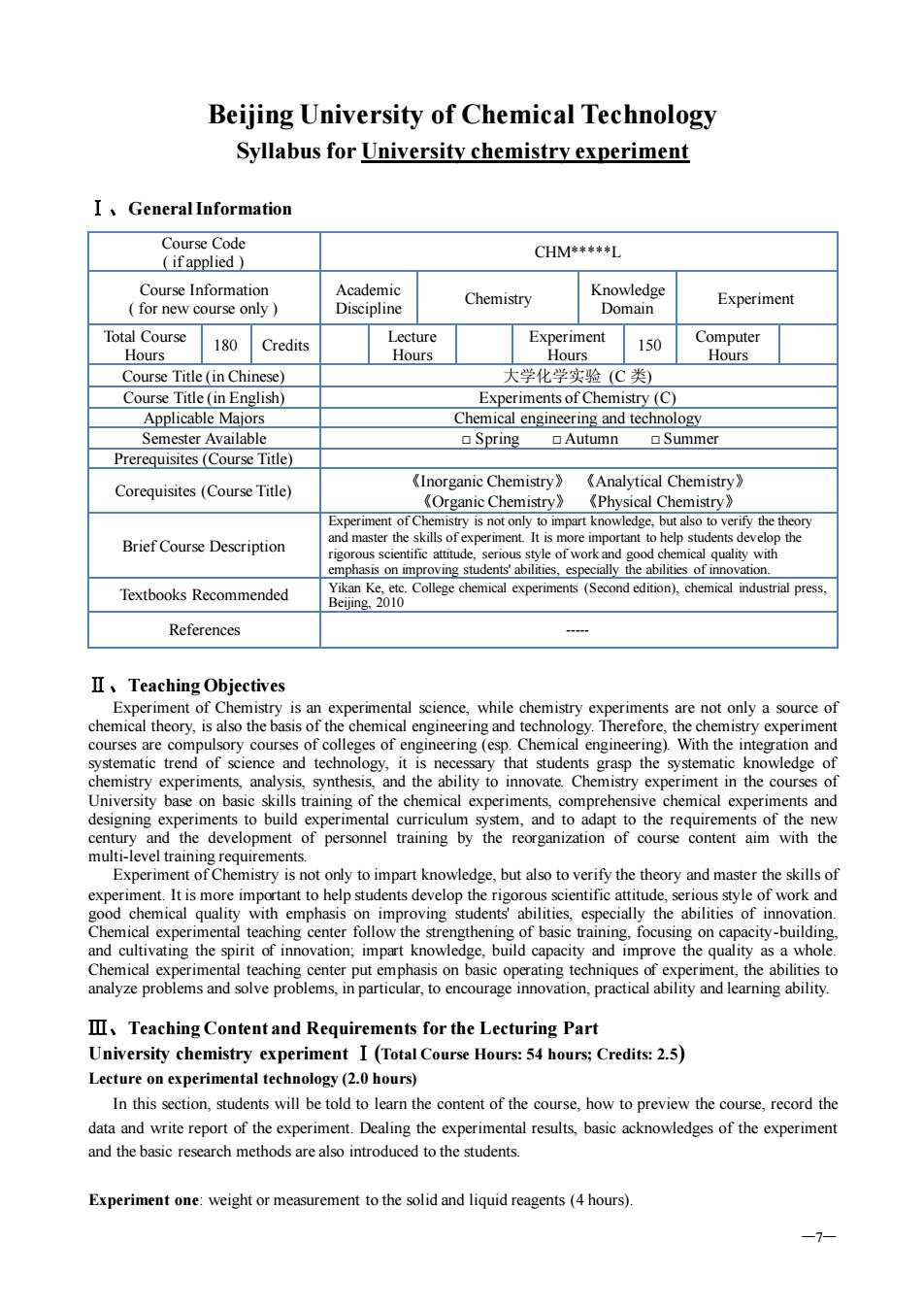
Beijing University of Chemical Technology Syllabus for University chemistry experiment CHM华幸L Course Information (for new course only) Chemistry Knowledge Experiment Domain Total Course 180 Credits Lecture Experiment 150 Computer Hours Hours lours Hours Course Title(in Chinese) 大学化学实验(C类) Course Tite (in English) Experiments of Chemistry (C) Applica Spring Summer Corequisites(Course Title) 《Inorganic Chemistry》 Analytical chemistry 《Organic chemistry》《Physical chemistry》 Brief Course Description Textbooks Recommended pCol hmir cheicu References Ⅱ、Teaching Objectives h courses are compulsory courses colleges of engineering (esp.Chemical engineering).With the inte on and d the that st th the University base on of the comprehensive chemical xperiments and equirements ledge.but also to verify the e th eory and master the skillso experimental teac city-buil e sp mpa asis o I Teaching Content and Requirements for the Lecturing Part University chemistry experiment I (Total Course Hours:54 hours;Credits:2.5) Lecture on experimental technology (2.0 hours) In will be told to lean the of the course how to preview record the write report of the alresults,basic acknowledges of the experimen s are also introduced to the student Experiment one:weight or measurement to the solid and liquid reagents(4 hours)
—7— Beijing University of Chemical Technology Syllabus for University chemistry experiment Ⅰ、General Information Course Code ( if applied ) CHM*****L Course Information ( for new course only ) Academic Discipline Chemistry Knowledge Domain Experiment Total Course Hours 180 Credits Lecture Hours Experiment Hours 150 Computer Hours Course Title (in Chinese) 大学化学实验 (C 类) Course Title (in English) Experiments of Chemistry (C) Applicable Majors Chemical engineering and technology Semester Available □ Spring □ Autumn □ Summer Prerequisites (Course Title) Corequisites (Course Title) 《Inorganic Chemistry》 《Analytical Chemistry》 《Organic Chemistry》 《Physical Chemistry》 Brief Course Description Experiment of Chemistry is not only to impart knowledge, but also to verify the theory and master the skills of experiment. It is more important to help students develop the rigorous scientific attitude, serious style of work and good chemical quality with emphasis on improving students' abilities, especially the abilities of innovation. Textbooks Recommended Yikan Ke, etc. College chemical experiments (Second edition), chemical industrial press, Beijing, 2010 References ----- Ⅱ、Teaching Objectives Experiment of Chemistry is an experimental science, while chemistry experiments are not only a source of chemical theory, is also the basis of the chemical engineering and technology. Therefore, the chemistry experiment courses are compulsory courses of colleges of engineering (esp. Chemical engineering). With the integration and systematic trend of science and technology, it is necessary that students grasp the systematic knowledge of chemistry experiments, analysis, synthesis, and the ability to innovate. Chemistry experiment in the courses of University base on basic skills training of the chemical experiments, comprehensive chemical experiments and designing experiments to build experimental curriculum system, and to adapt to the requirements of the new century and the development of personnel training by the reorganization of course content aim with the multi-level training requirements. Experiment of Chemistry is not only to impart knowledge, but also to verify the theory and master the skills of experiment. It is more important to help students develop the rigorous scientific attitude, serious style of work and good chemical quality with emphasis on improving students' abilities, especially the abilities of innovation. Chemical experimental teaching center follow the strengthening of basic training, focusing on capacity-building, and cultivating the spirit of innovation; impart knowledge, build capacity and improve the quality as a whole. Chemical experimental teaching center put emphasis on basic operating techniques of experiment, the abilities to analyze problems and solve problems, in particular, to encourage innovation, practical ability and learning ability. Ⅲ、Teaching Content and Requirements for the Lecturing Part University chemistry experiment Ⅰ(Total Course Hours: 54 hours; Credits: 2.5) Lecture on experimental technology (2.0 hours) In this section, students will be told to learn the content of the course, how to preview the course, record the data and write report of the experiment. Dealing the experimental results, basic acknowledges of the experiment and the basic research methods are also introduced to the students. Experiment one: weight or measurement to the solid and liquid reagents (4 hours)
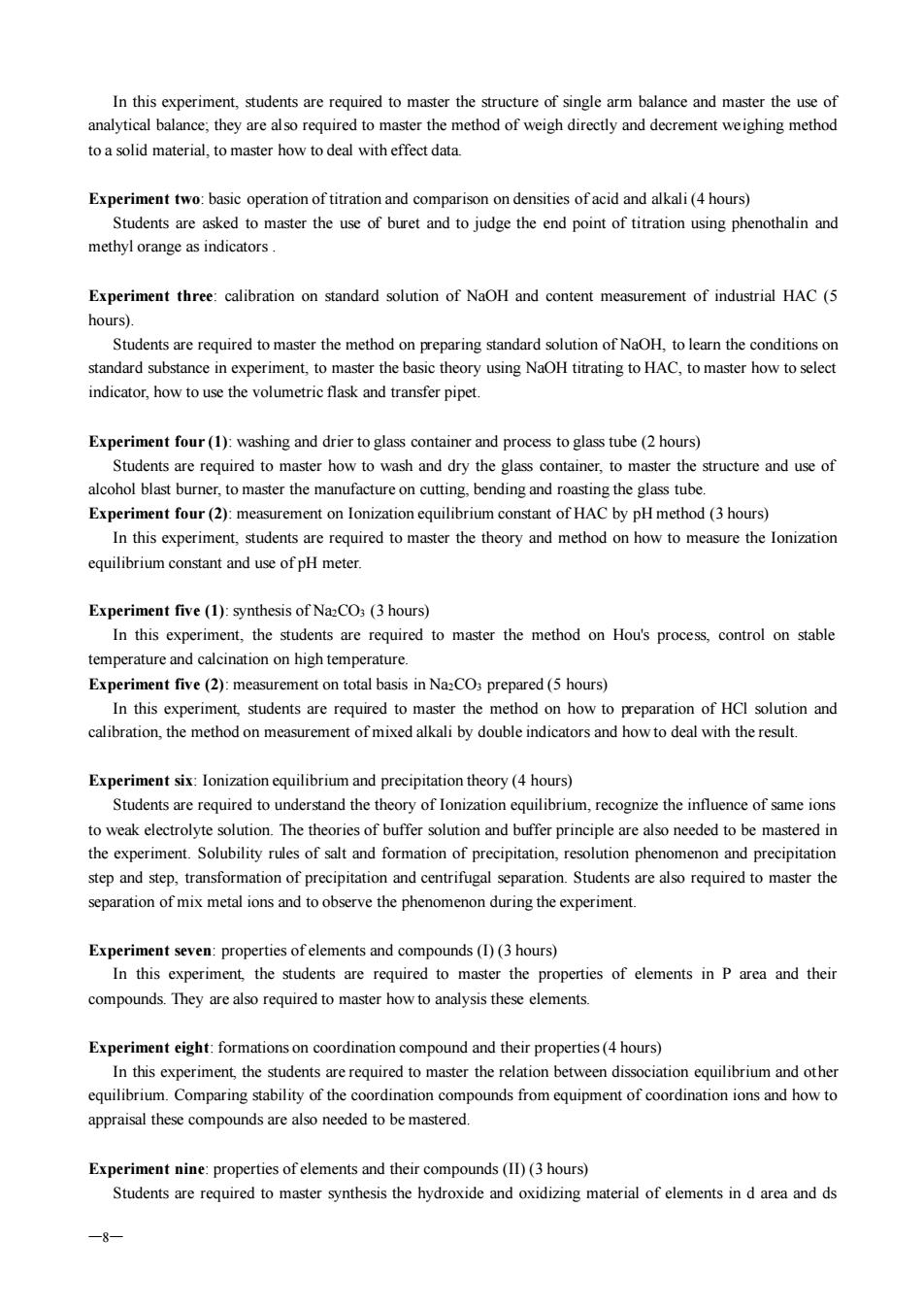
In this experiment,students are required to master the structure of single arm balance and master the use of analytical balance:they are also required to master the method of weigh directly and decrement weighing method Experiment two:basic operation of titration and comparison on densities of acid and alkali(4 hours) Students are asked to master the use of buret and to judge the end point of titration using phenothalin and methyl orange as indicators Experiment three:calibration on standard solution of NaOH and content measurement of industrial HAC(5 hours). Students are required to master the method on preparing standard solution of NaOH,to learn the conditions on standard substance in experiment.to master the basic theory using NaOH titrating to HAC.to master how to select indicator,how touse the volumetric flask and transfer pipet. Experiment four(1):washing and drier to glass container and process toglass tube(2hours) Students are required to master how to wash and dry the glass container,to master the structure and use of alcohol blast burner,to master the manufacture on cutting,bending and roasting the glass tube. Experiment four (2):measurement on lonization equilibrium constant of HAC by pHmethod (3 hours) In this experiment,studer required to master the theory and method on how to measure the lonization equilibrium constant and use of pH meter. Experiment five(1):synthesis of NaCO3(3 hours) In this experiment.the students are required to master the method on Hou's process.control on stable surement on total basis in NaCO prepared(5 hours) In this experiment students are required to master the method on how to preparation of HCI solution and calibration,the method on measurement of mixed alkali by double indicators and how to deal with the result. Experiment six:lonization equilibri thery (4hours) to weak electrolyte solution.The theories of buffer solution and buffer principle are also needed to be mastered in the experiment.Solubility rules of salt and formation of precipitation.resolution phenomenon and precipitation step and step,transformation of precipitation and centrifugal separation.Students are also required to master the separation of mix metal ions and toobserve the phenomenon during the experiment Experiment seven:properties ofelements and compounds(1(3 hours) In this experiment,the students are required to master the properties of elements in P area and their compounds.They are also required to master how to analysis these elements. coordin ompound and(hour) udents arerequired to master the relation between dis and othe equilibrium.Comparing stability of the coordination compounds from equipment of coordination ions and how to appraisal these compounds are also needed to be mastered Experiment nine:properties ofelements and their compounds (I)(3hours)
—8— In this experiment, students are required to master the structure of single arm balance and master the use of analytical balance; they are also required to master the method of weigh directly and decrement weighing method to a solid material, to master how to deal with effect data. Experiment two: basic operation of titration and comparison on densities of acid and alkali (4 hours) Students are asked to master the use of buret and to judge the end point of titration using phenothalin and methyl orange as indicators . Experiment three: calibration on standard solution of NaOH and content measurement of industrial HAC (5 hours). Students are required to master the method on preparing standard solution of NaOH, to learn the conditions on standard substance in experiment, to master the basic theory using NaOH titrating to HAC, to master how to select indicator, how to use the volumetric flask and transfer pipet. Experiment four (1): washing and drier to glass container and process to glass tube (2 hours) Students are required to master how to wash and dry the glass container, to master the structure and use of alcohol blast burner, to master the manufacture on cutting, bending and roasting the glass tube. Experiment four (2): measurement on Ionization equilibrium constant of HAC by pH method (3 hours) In this experiment, students are required to master the theory and method on how to measure the Ionization equilibrium constant and use of pH meter. Experiment five (1): synthesis of Na2CO3 (3 hours) In this experiment, the students are required to master the method on Hou's process, control on stable temperature and calcination on high temperature. Experiment five (2): measurement on total basis in Na2CO3 prepared (5 hours) In this experiment, students are required to master the method on how to preparation of HCl solution and calibration, the method on measurement of mixed alkali by double indicators and how to deal with the result. Experiment six: Ionization equilibrium and precipitation theory (4 hours) Students are required to understand the theory of Ionization equilibrium, recognize the influence of same ions to weak electrolyte solution. The theories of buffer solution and buffer principle are also needed to be mastered in the experiment. Solubility rules of salt and formation of precipitation, resolution phenomenon and precipitation step and step, transformation of precipitation and centrifugal separation. Students are also required to master the separation of mix metal ions and to observe the phenomenon during the experiment. Experiment seven: properties of elements and compounds (I) (3 hours) In this experiment, the students are required to master the properties of elements in P area and their compounds. They are also required to master how to analysis these elements. Experiment eight: formations on coordination compound and their properties (4 hours) In this experiment, the students are required to master the relation between dissociation equilibrium and other equilibrium. Comparing stability of the coordination compounds from equipment of coordination ions and how to appraisal these compounds are also needed to be mastered. Experiment nine: properties of elements and their compounds (II) (3 hours) Students are required to master synthesis the hydroxide and oxidizing material of elements in d area and ds
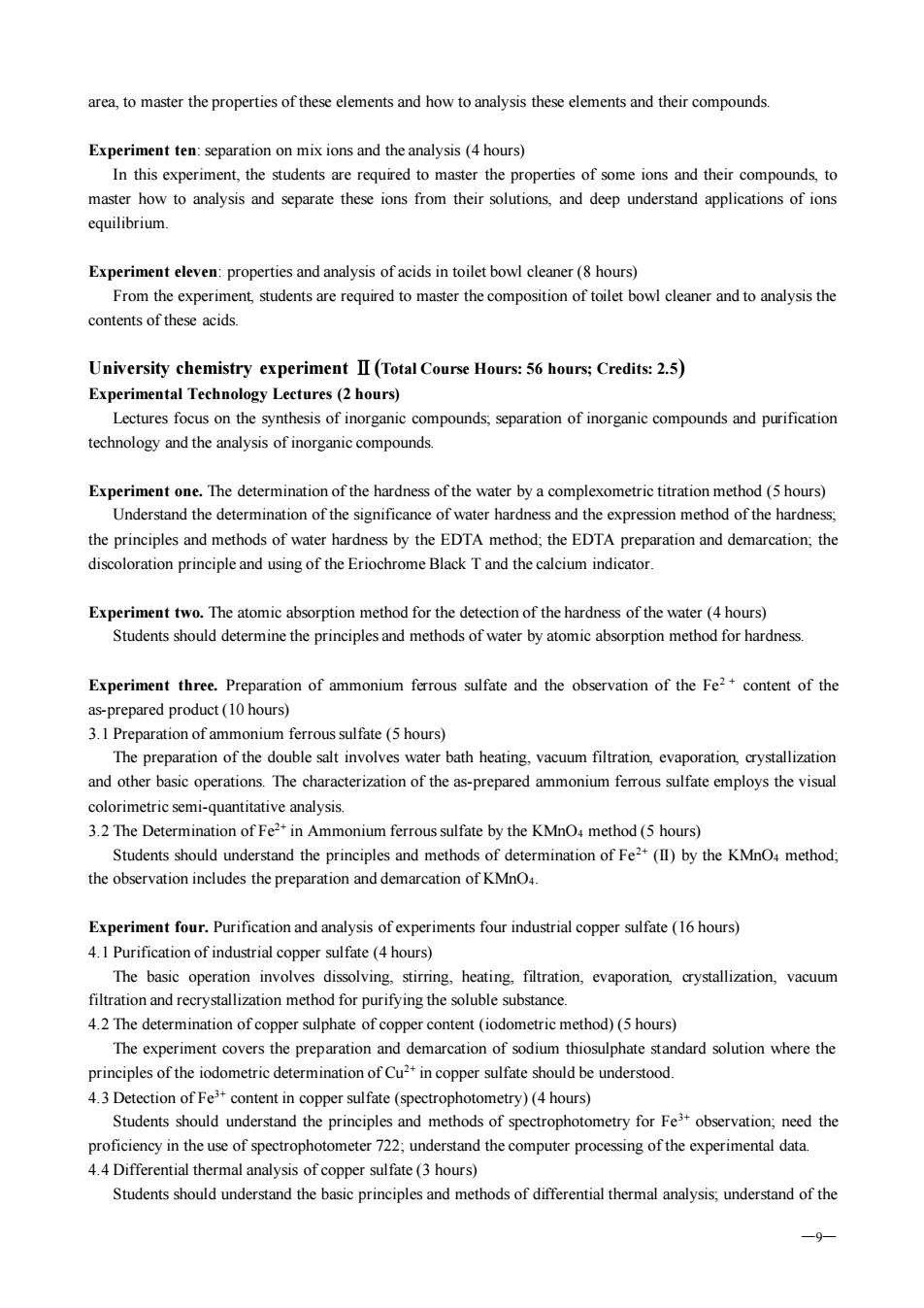
area,to master the properties of these elements and how to analysis these elements and their compounds. Experiment ionsand the analysis (4hours) In this experiment,the students are required to master the properties of some ions and their compounds,to master how to analysis and separate these ions from their solutions,and deep understand applications of ions equilibrium properties and analysis of acids in toilt bowl(hours) From the to master the of toilet and to analysis the contents of these acids. University chemistry experiment II(Total Course Hours:56 hours;Credits:2.5) Lectures fo uson the synthesis of inorganic compounds,sparation of inorganic compounds and purification technology and the analysis of inorganic compounds. Experiment one.The determination of the hardness of the water by a complexometric titration method(5 hours) Understand the determination of the significance of water hardness and the expression method of the hardness. the principles and methods of water hardness by the EDTA method,the EDTA preparation and demarcation,the discoloration principle and using of the Eriochrome Black T and the calcium indicator Experiment two.The atomic absorption method for the detection of the hardness of the water(4 hours) Students should determine the principles and methods of water by atomic absorption method for hardness. Experiment three.Preparation of ammonium ferrous sulfate and the observation of the Fecontent of the as-prepared product(10 hours) 3.1 Preparation of ammonium ferrous sulfate(5 hours) The preparation of the double salt involves water bath heating.vacuum filtration,evaporation,crystallization and other basic operations.The characterization of the as-prepared ammonium ferrous sulfate employs the visual analysis 3.2 The Determination of Fe-"in Ammonium ferrous sulfate by the KMnO4 method (5 hours) Students should understand the principles and methods of determination of Fe(II)by the KMnO method: the observation includes the preparation and demarcation of KMnO. Experiment four.Purification and analysis of experiments four industrial copper sulfate(16hours) 4.I Purification of industrial copper sulfate (4 hours) The basic operation involves dissolving.stirring,heating.filtration,evaporation,crystallization,vacuum filtration and recrystallization method for purifying the soluble substance. 4.2 The determination of copper sulphate of copper content (iodometric method)(5 hours) The experiment covers th preparation and where the principles of the iodometricdetermination of Cuin copper sulfate should be understood 4.3 Detection of Fecontent in copper sulfate(spectrophotometry)(4 hours) Students should understand the principles and methods of spectrophotometry for Feobservation,need the proficiency in the use of spectrophotometer 722:understand the computer processing of the experimental data. 4.Differential thermal analysis of copper sulfate(3 hours) Stdents shou nderstand the b understand fth -0
—9— area, to master the properties of these elements and how to analysis these elements and their compounds. Experiment ten: separation on mix ions and the analysis (4 hours) In this experiment, the students are required to master the properties of some ions and their compounds, to master how to analysis and separate these ions from their solutions, and deep understand applications of ions equilibrium. Experiment eleven: properties and analysis of acids in toilet bowl cleaner (8 hours) From the experiment, students are required to master the composition of toilet bowl cleaner and to analysis the contents of these acids. University chemistry experiment Ⅱ(Total Course Hours: 56 hours; Credits: 2.5) Experimental Technology Lectures (2 hours) Lectures focus on the synthesis of inorganic compounds; separation of inorganic compounds and purification technology and the analysis of inorganic compounds. Experiment one. The determination of the hardness of the water by a complexometric titration method (5 hours) Understand the determination of the significance of water hardness and the expression method of the hardness; the principles and methods of water hardness by the EDTA method; the EDTA preparation and demarcation; the discoloration principle and using of the Eriochrome Black T and the calcium indicator. Experiment two. The atomic absorption method for the detection of the hardness of the water (4 hours) Students should determine the principles and methods of water by atomic absorption method for hardness. Experiment three. Preparation of ammonium ferrous sulfate and the observation of the Fe2 + content of the as-prepared product (10 hours) 3.1 Preparation of ammonium ferrous sulfate (5 hours) The preparation of the double salt involves water bath heating, vacuum filtration, evaporation, crystallization and other basic operations. The characterization of the as-prepared ammonium ferrous sulfate employs the visual colorimetric semi-quantitative analysis. 3.2 The Determination of Fe2+ in Ammonium ferrous sulfate by the KMnO4 method (5 hours) Students should understand the principles and methods of determination of Fe2+ (II) by the KMnO4 method; the observation includes the preparation and demarcation of KMnO4. Experiment four. Purification and analysis of experiments four industrial copper sulfate (16 hours) 4.1 Purification of industrial copper sulfate (4 hours) The basic operation involves dissolving, stirring, heating, filtration, evaporation, crystallization, vacuum filtration and recrystallization method for purifying the soluble substance. 4.2 The determination of copper sulphate of copper content (iodometric method) (5 hours) The experiment covers the preparation and demarcation of sodium thiosulphate standard solution where the principles of the iodometric determination of Cu2+ in copper sulfate should be understood. 4.3 Detection of Fe3+ content in copper sulfate (spectrophotometry) (4 hours) Students should understand the principles and methods of spectrophotometry for Fe3+ observation; need the proficiency in the use of spectrophotometer 722; understand the computer processing of the experimental data. 4.4 Differential thermal analysis of copper sulfate (3 hours) Students should understand the basic principles and methods of differential thermal analysis; understand of the
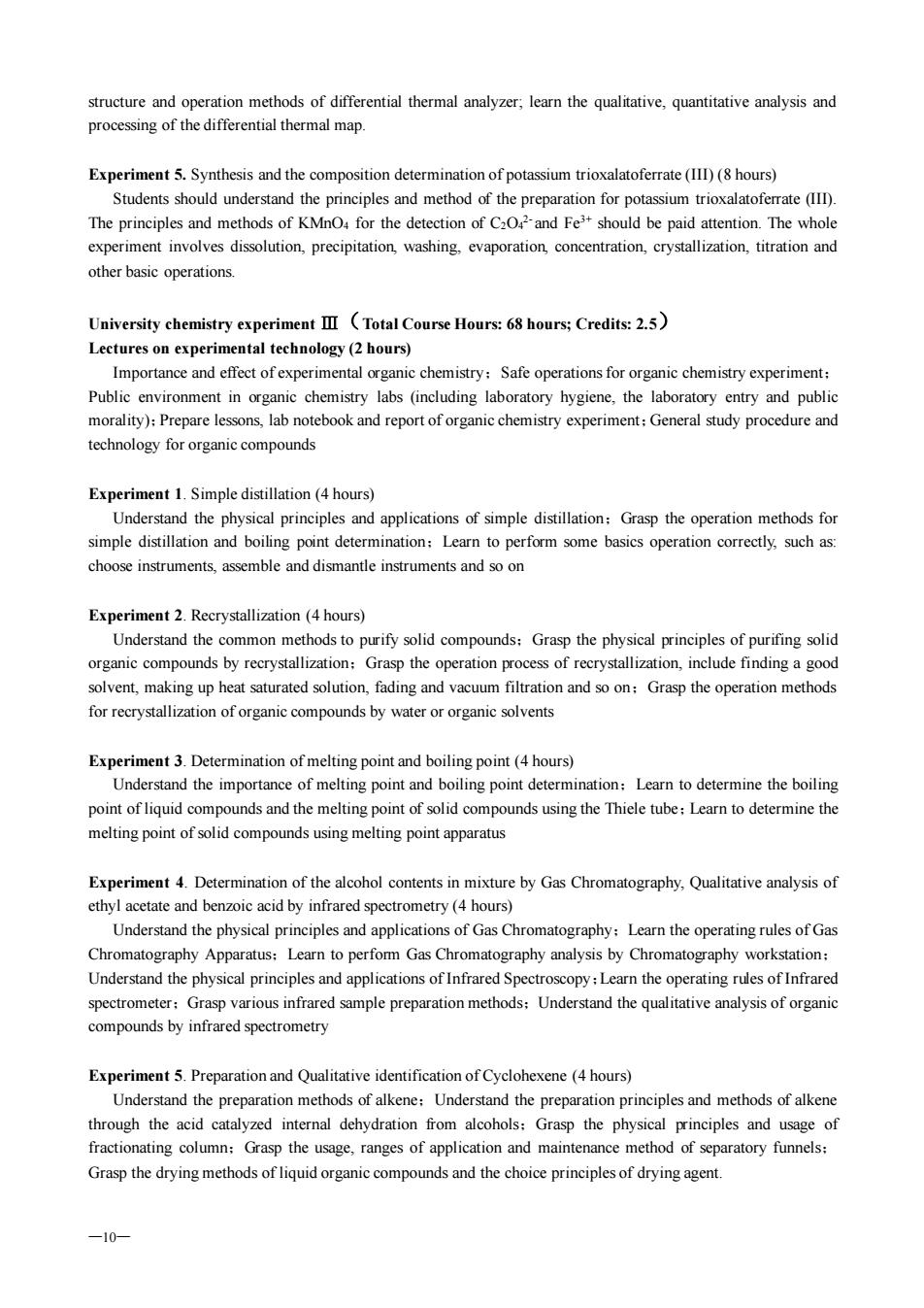
structure and operation methods of differential thermal analyzer:learn the qualitative.quantitative analysis and rocessing of the differential thermal map. Experiment 5.Synthesis and the composition determination of potassium trioxalatoferrate(II)(hours) Students should understand the principles and method of the preparation for potassium trioxalatoferrate(I) The principles and methods of KMnO for the detection of Cand Feshould be paid attention.The whole experiment involves dissolution,precipitation washing.evaporation concentration,crystallization,titration and other basic operations University chemistry experiment II (Total Course Hours:68 hours;Credits:2.5) Importance and fe ofexperimental organic chemistry:Safe operations for organic chemistry experiment Public environment in organic chemistry labs (including laboratory hygiene,the laboratory entry and public morality):Prepare lessons,lab notebook and report of organic chemistry experiment:General study procedure and technology for organic compounds Experiment 1.Simple distillation (4hours) Understand the physical principles and applications of simple distillation:Grasp the operation methods for simple distillation and boiling point determination:Learn to perform some basics operation correctly,such as: choose instruments,assemble and dismantle instruments and so on m theyinclof organic compounds by recrystallization:Grasp the operation process of recrystallization,include finding a gooc solvent,making up heat saturated solution,fading and vacuum filtration and so on:Grasp the operation methods for recrystallization of organic compounds by water or organic solvents Experiment.Determination pointand boilingpoint (4hours) Understand the importance of melting point and boiling point determination:Learn to determine the boiling point of liquid compounds and the melting point of solid compounds using the Thiele tube:Learn to determine the melting point of solid compounds using melting point apparatus ethyl acetate and benzoic acid by infrared spectrometry(4 hours) Understand the physical principles and applications of Gas Chromatography:Learn the operating rules of Gas Chromatography Apparatus:Learn to perfom Gas Chromatography analysis by Chromatography workstation: Understand the physical principles and applications of Infrared Spectroscopy:Learn the operating rues of Infrared sp various infrared sample preparation methods:Unde stand the qualitative analysis compo Experiment 5.Preparation and Qualitative identification of Cyclohexene(4 hours) Understand the preparation methods of alkene:Understand the preparation principles and methods of alkene through the acid catalyzed internal dehydration from alcohols:Grasp the physical principles and usage of usage ranges sof application and maintena ce Grasp the drying methods of liquid organic compounds and the choice principles of drying agent -10
—10— structure and operation methods of differential thermal analyzer; learn the qualitative, quantitative analysis and processing of the differential thermal map. Experiment 5. Synthesis and the composition determination of potassium trioxalatoferrate (III) (8 hours) Students should understand the principles and method of the preparation for potassium trioxalatoferrate (III). The principles and methods of KMnO4 for the detection of C2O4 2- and Fe3+ should be paid attention. The whole experiment involves dissolution, precipitation, washing, evaporation, concentration, crystallization, titration and other basic operations. University chemistry experiment Ⅲ(Total Course Hours: 68 hours; Credits: 2.5) Lectures on experimental technology (2 hours) Importance and effect of experimental organic chemistry;Safe operations for organic chemistry experiment; Public environment in organic chemistry labs (including laboratory hygiene, the laboratory entry and public morality);Prepare lessons, lab notebook and report of organic chemistry experiment;General study procedure and technology for organic compounds Experiment 1. Simple distillation (4 hours) Understand the physical principles and applications of simple distillation;Grasp the operation methods for simple distillation and boiling point determination;Learn to perform some basics operation correctly, such as: choose instruments, assemble and dismantle instruments and so on Experiment 2. Recrystallization (4 hours) Understand the common methods to purify solid compounds;Grasp the physical principles of purifing solid organic compounds by recrystallization;Grasp the operation process of recrystallization, include finding a good solvent, making up heat saturated solution, fading and vacuum filtration and so on;Grasp the operation methods for recrystallization of organic compounds by water or organic solvents Experiment 3. Determination of melting point and boiling point (4 hours) Understand the importance of melting point and boiling point determination;Learn to determine the boiling point of liquid compounds and the melting point of solid compounds using the Thiele tube;Learn to determine the melting point of solid compounds using melting point apparatus Experiment 4. Determination of the alcohol contents in mixture by Gas Chromatography, Qualitative analysis of ethyl acetate and benzoic acid by infrared spectrometry (4 hours) Understand the physical principles and applications of Gas Chromatography;Learn the operating rules of Gas Chromatography Apparatus;Learn to perform Gas Chromatography analysis by Chromatography workstation; Understand the physical principles and applications of Infrared Spectroscopy;Learn the operating rules of Infrared spectrometer;Grasp various infrared sample preparation methods;Understand the qualitative analysis of organic compounds by infrared spectrometry Experiment 5. Preparation and Qualitative identification of Cyclohexene (4 hours) Understand the preparation methods of alkene;Understand the preparation principles and methods of alkene through the acid catalyzed internal dehydration from alcohols;Grasp the physical principles and usage of fractionating column;Grasp the usage, ranges of application and maintenance method of separatory funnels; Grasp the drying methods of liquid organic compounds and the choice principles of drying agent